Abstract
The mediated transport of citrate in Aerobacter aerogenes was studied. According to data obtained by examining the distribution of radioactive citrate at room temperature and at 0 C, a carrier system appears to be located on the membrane. The carrier system is inducible and very specific, not acting on the related compounds isocitrate and cis-aconitate. Induction required synthesis of both ribonucleic acid and protein as determined by starving auxotrophic mutants and by using specific inhibitors of protein synthesis. Citrate transport was inhibited by N-ethyl maleimide, dinitrofluorobenzene, and uranyl nitrate. A kinetic study of uranyl nitrate inhibition revealed that the inhibition of citrate transport was different from that of glucose penetration. Cyanide also discriminated citrate from glucose penetration inhibiting only the former. These last results suggested that energy is required for citrate penetration.
Full text
PDF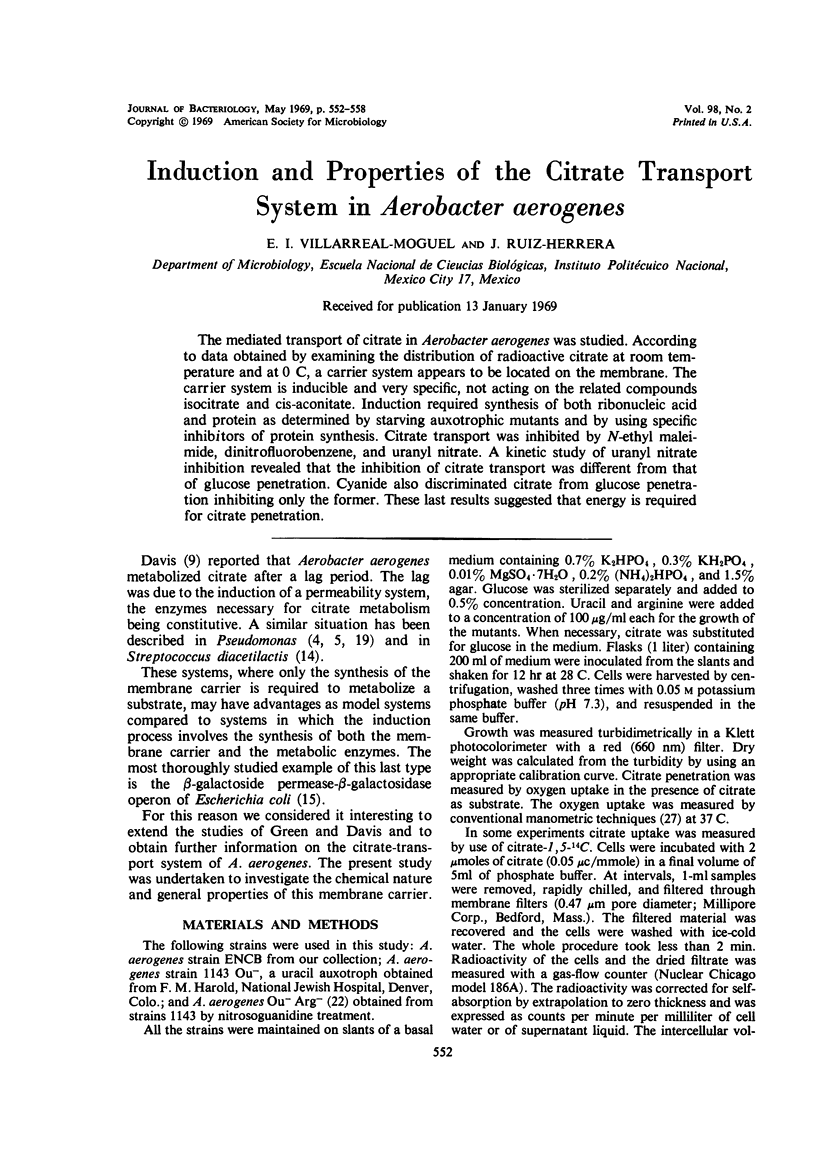
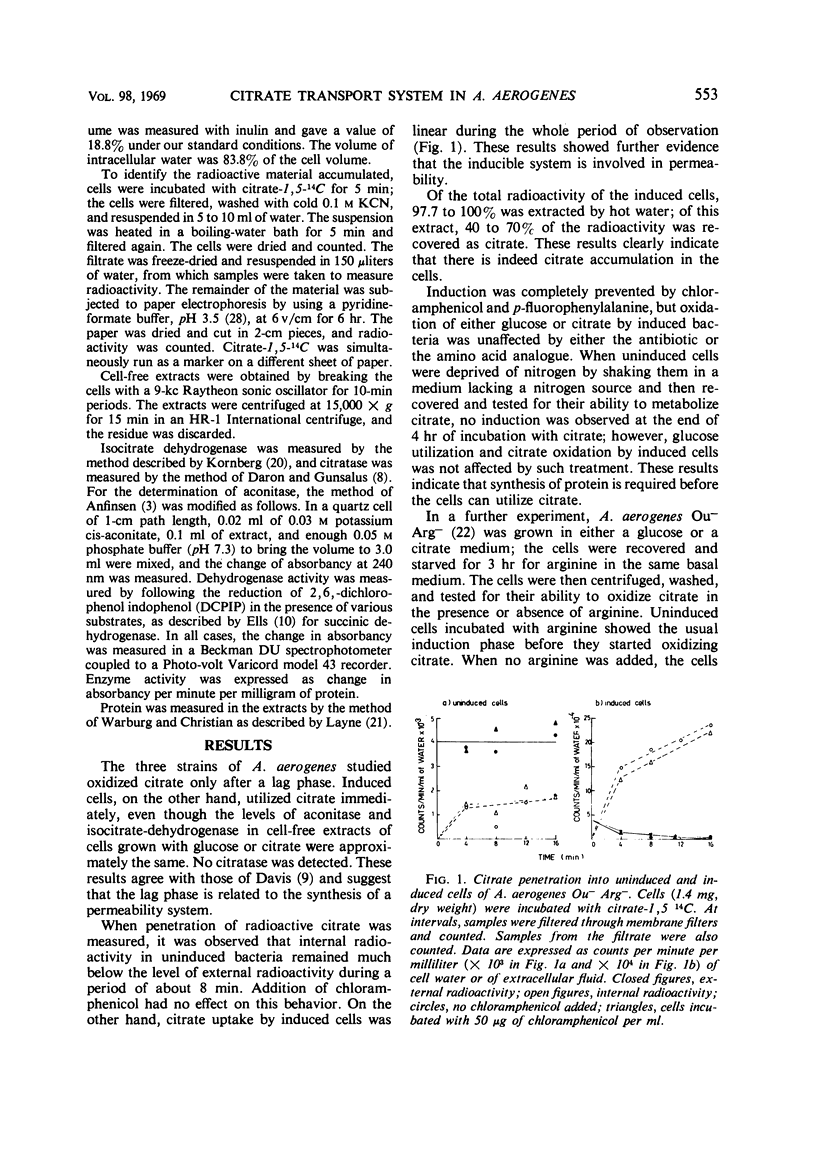
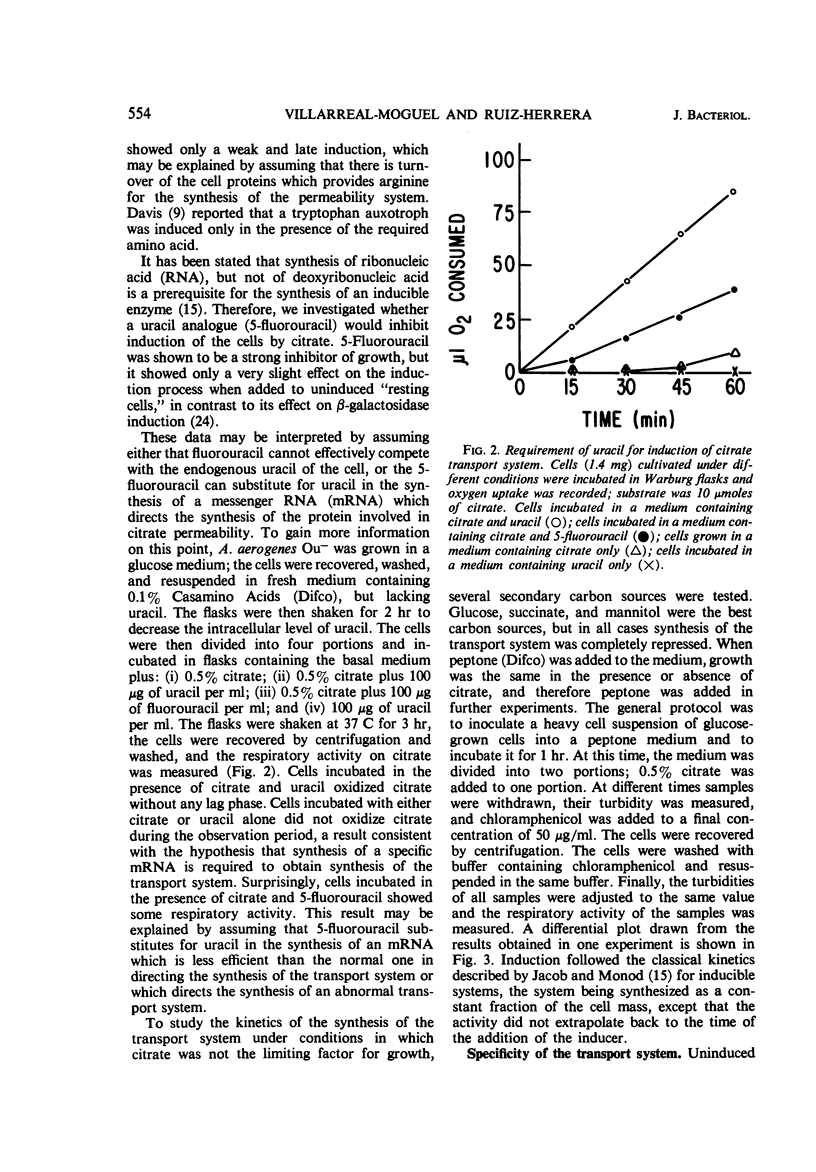
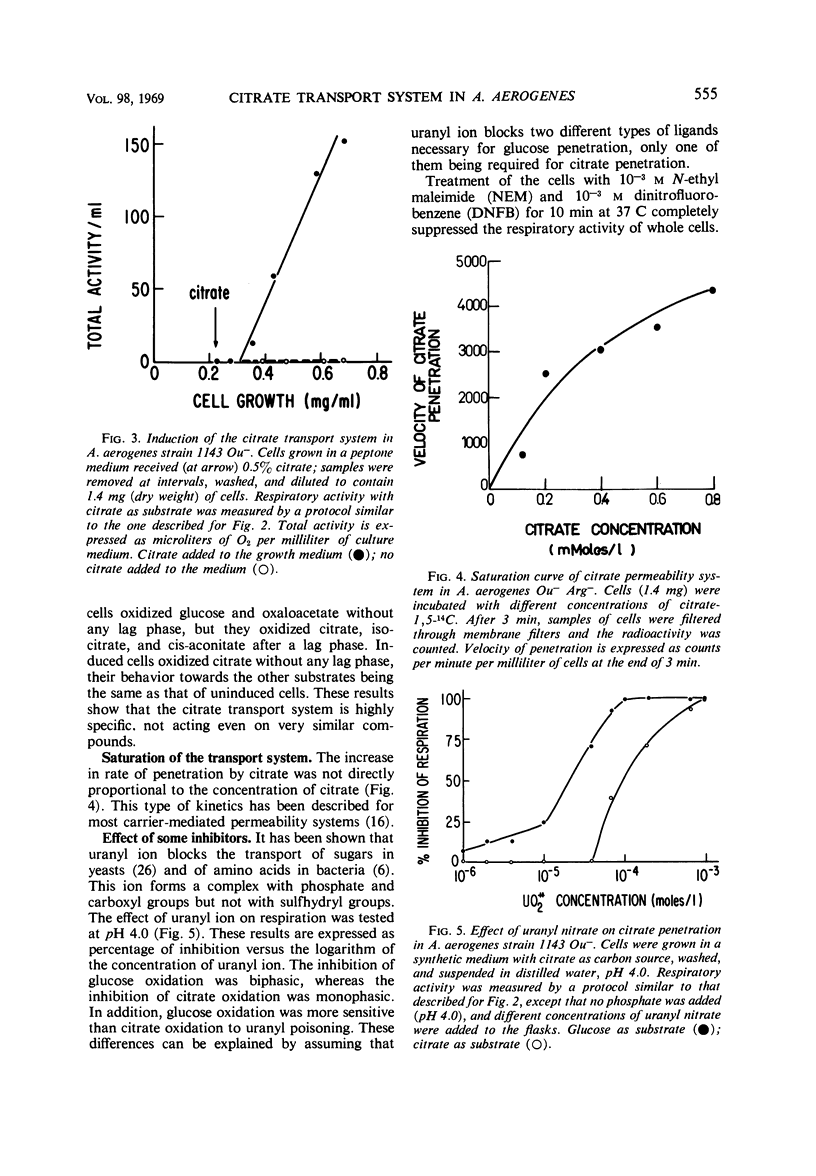
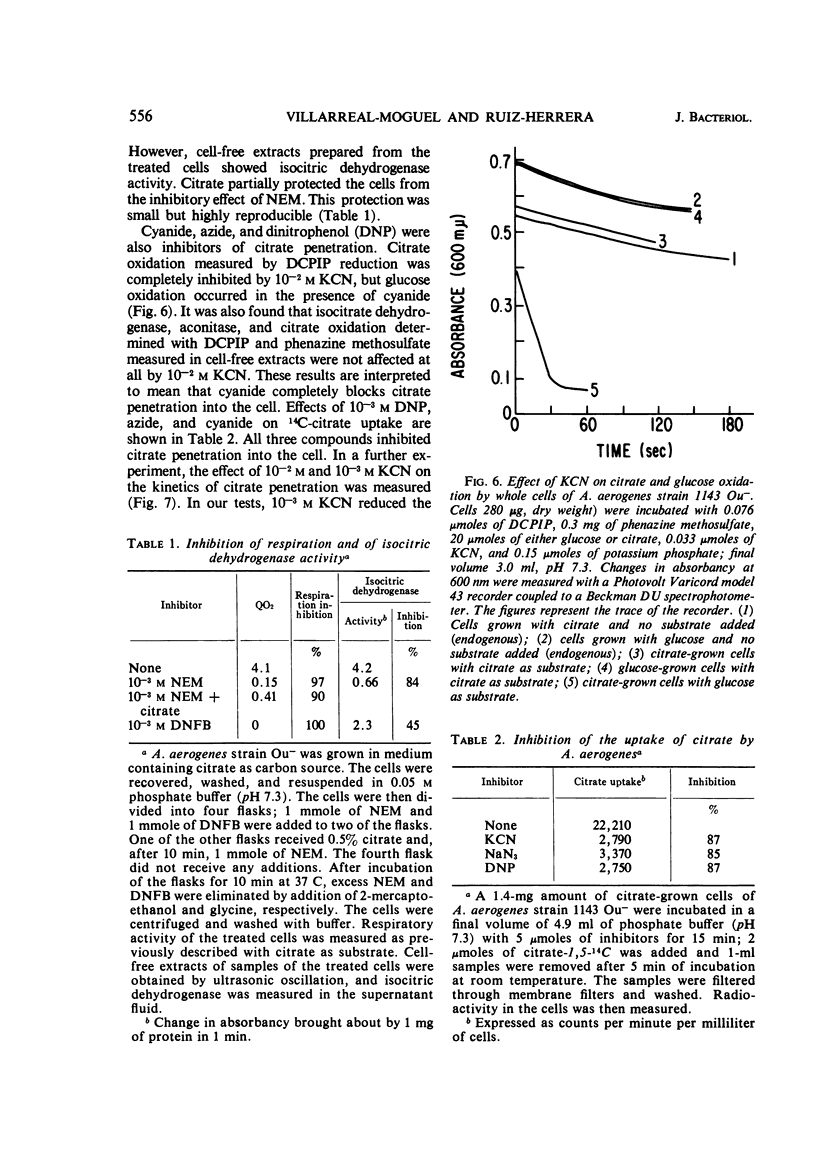

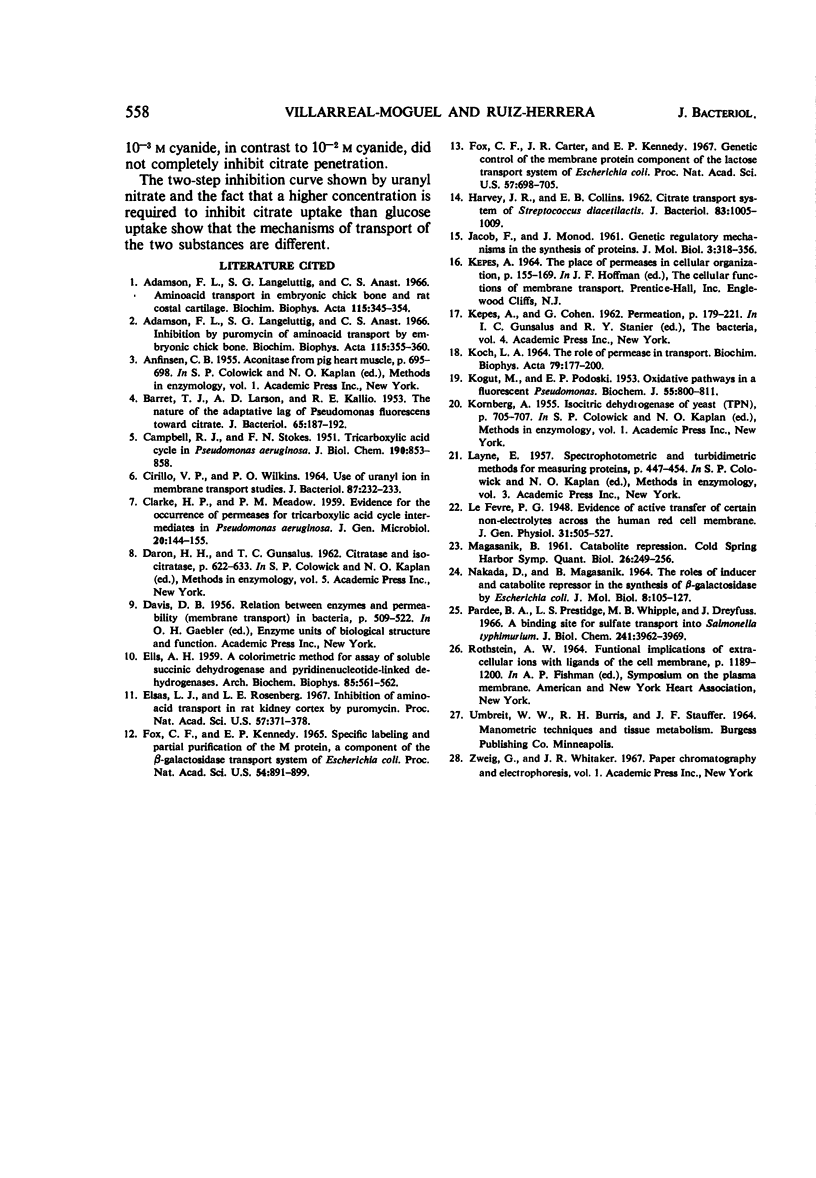
Selected References
These references are in PubMed. This may not be the complete list of references from this article.
- Adamson L. F., Langeluttig S. G., Anast C. S. Amino acid transport in embryonic chick bone and rat costal cartilage. Biochim Biophys Acta. 1966 Feb 28;115(2):345–354. doi: 10.1016/0304-4165(66)90434-x. [DOI] [PubMed] [Google Scholar]
- Adamson L. F., Langeluttig S. G., Anast C. S. Inhibition by puromycin of amino acid transport by embryonic chick bone. Biochim Biophys Acta. 1966 Feb 28;115(2):355–360. doi: 10.1016/0304-4165(66)90435-1. [DOI] [PubMed] [Google Scholar]
- BARRETT J. T., LARSON A. D., KALLIO R. E. The nature of the adaptive lag of Pseudomonas fluorescens toward citrate. J Bacteriol. 1953 Feb;65(2):187–192. doi: 10.1128/jb.65.2.187-192.1953. [DOI] [PMC free article] [PubMed] [Google Scholar]
- CAMPBELL J. J. R., STOKES F. N. Tricarboxylic acid cycle in Pseudomonas aeruginosa. J Biol Chem. 1951 Jun;190(2):853–858. [PubMed] [Google Scholar]
- CIRILLO V. P., WILKINS P. O. USE OF URANYL ION IN MEMBRANE TRANSPORT STUDIES. J Bacteriol. 1964 Jan;87:232–233. doi: 10.1128/jb.87.1.232-233.1964. [DOI] [PMC free article] [PubMed] [Google Scholar]
- CLARKE P. H., MEADOW P. M. Evidence for the occurrence of Permeases for tricarboxylic acid cycle intermediates in Pseudomonas aeruginosa. J Gen Microbiol. 1959 Feb;20(1):144–155. doi: 10.1099/00221287-20-1-144. [DOI] [PubMed] [Google Scholar]
- ELLS H. A. A colorimetric method for the assay of soluble succinic dehydrogenase and pyridinenucleotide-linked dehydrogenases. Arch Biochem Biophys. 1959 Dec;85:561–562. doi: 10.1016/0003-9861(59)90527-2. [DOI] [PubMed] [Google Scholar]
- Elsas L. J., Rosenberg L. E. Inhibition of amino Acid transport in rat kidney cortex by puromycin. Proc Natl Acad Sci U S A. 1967 Feb;57(2):371–378. doi: 10.1073/pnas.57.2.371. [DOI] [PMC free article] [PubMed] [Google Scholar]
- Fox C. F., Carter J. R., Kennedy E. P. GENETIC CONTROL OF THE MEMBRANE PROTEIN COMPONENT OF THE LACTOSE TRANSPORT SYSTEM OF Escherichia coli. Proc Natl Acad Sci U S A. 1967 Mar;57(3):698–705. doi: 10.1073/pnas.57.3.698. [DOI] [PMC free article] [PubMed] [Google Scholar]
- Fox C. F., Kennedy E. P. Specific labeling and partial purification of the M protein, a component of the beta-galactoside transport system of Escherichia coli. Proc Natl Acad Sci U S A. 1965 Sep;54(3):891–899. doi: 10.1073/pnas.54.3.891. [DOI] [PMC free article] [PubMed] [Google Scholar]
- HARVEY R. J., COLLINS E. B. Citrate transport system of Streptococcus diacetilactis. J Bacteriol. 1962 May;83:1005–1009. doi: 10.1128/jb.83.5.1005-1009.1962. [DOI] [PMC free article] [PubMed] [Google Scholar]
- JACOB F., MONOD J. Genetic regulatory mechanisms in the synthesis of proteins. J Mol Biol. 1961 Jun;3:318–356. doi: 10.1016/s0022-2836(61)80072-7. [DOI] [PubMed] [Google Scholar]
- KOCH A. L. THE ROLE OF PERMEASE IN TRANSPORT. Biochim Biophys Acta. 1964 Jan 27;79:177–200. doi: 10.1016/0926-6577(64)90050-6. [DOI] [PubMed] [Google Scholar]
- KOGUT M., PODOSKI E. P. Oxidative pathways in a fluorescent Pseudomonas. Biochem J. 1953 Dec;55(5):800–811. doi: 10.1042/bj0550800. [DOI] [PMC free article] [PubMed] [Google Scholar]
- MAGASANIK B. Catabolite repression. Cold Spring Harb Symp Quant Biol. 1961;26:249–256. doi: 10.1101/sqb.1961.026.01.031. [DOI] [PubMed] [Google Scholar]
- NAKADA D., MAGASANIK B. THE ROLES OF INDUCER AND CATABOLITE REPRESSOR IN THE SYNTHESIS OF BETA-GALACTOSIDASE BY ESCHERICHIA COLI. J Mol Biol. 1964 Jan;8:105–127. doi: 10.1016/s0022-2836(64)80153-4. [DOI] [PubMed] [Google Scholar]
- Pardee A. B., Prestidge L. S., Whipple M. B., Dreyfuss J. A binding site for sulfate and its relation to sulfate transport into Salmonella typhimurium. J Biol Chem. 1966 Sep 10;241(17):3962–3969. [PubMed] [Google Scholar]


